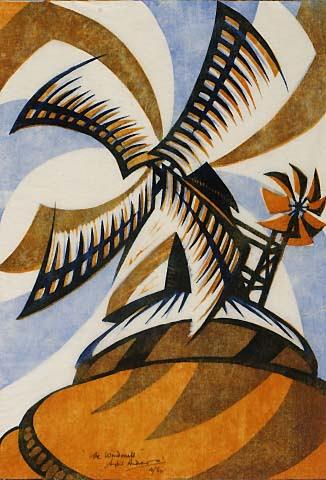-
Mills on Art ⁄ Windmill by Sybil Andrews
Linocut "Windmill", 1933

Sybil Andrews (19 April 1898 - 21 December 1992) was a British-born (Bury St Edmunds) Canadian printmaker best known for her modernist linocuts.
Sybil trained in England , and began producing and exhibiting linocuts from 1921 until 1939, working frequently with her informal partner Cyril Edward Power. She also helped in the establishment and became the first secretary (1925 —1928)of the The Grosvenor School of Modern Art. She worked as a oxyacetylene welder in an aircraft factory in World War I, where she helped in the development of the first all metal aeroplane for the Bristol Welding Company. and in the shipyards of the Hampshire city of Southampton during World War II where she met Walter Morgan. In England one of the largest collections in public ownership is held by St Edmundsbury Borough Council Heritage Service Bury St Edmunds. This collection includes a number of early water-colour paintings, executed while the artist was still living in Suffolk.
In 1947 she married and moved to Canada with Walter Morgan, making her home in Campbell River, British Columbia. Sybil Andrews was elected to the Society of Canadian Painters, Etchers and Engravers in 1951 when her linocut Indian Dance was selected as the presentation print. There as well as teaching and continuing her own art in 1975 she completed one of her major works, The Banner of St Edmund. It is hand embroidered in silks on linen, and was first conceived, designed and begun in 1930. This banner now hangs in the Treasury of the St James Cathedral in the town of her birth.
The Glenbow Museum,Canada is a major centre for the study of her work with a collection of over 1000 examples of Andrews' works, including all of her famous colour linocuts and the original linoleum blocks, paintings in oil and watercolour, drawings, drypoint etchings, sketchbooks, and personal papers.2009.05.12